Xinlong Chen
VersaVid-R1: A Versatile Video Understanding and Reasoning Model from Question Answering to Captioning Tasks
Jun 10, 2025Abstract:Recent advancements in multimodal large language models have successfully extended the Reason-Then-Respond paradigm to image-based reasoning, yet video-based reasoning remains an underdeveloped frontier, primarily due to the scarcity of high-quality reasoning-oriented data and effective training methodologies. To bridge this gap, we introduce DarkEventInfer and MixVidQA, two novel datasets specifically designed to stimulate the model's advanced video understanding and reasoning abilities. DarkEventinfer presents videos with masked event segments, requiring models to infer the obscured content based on contextual video cues. MixVidQA, on the other hand, presents interleaved video sequences composed of two distinct clips, challenging models to isolate and reason about one while disregarding the other. Leveraging these carefully curated training samples together with reinforcement learning guided by diverse reward functions, we develop VersaVid-R1, the first versatile video understanding and reasoning model under the Reason-Then-Respond paradigm capable of handling multiple-choice and open-ended question answering, as well as video captioning tasks. Extensive experiments demonstrate that VersaVid-R1 significantly outperforms existing models across a broad spectrum of benchmarks, covering video general understanding, cognitive reasoning, and captioning tasks.
MME-VideoOCR: Evaluating OCR-Based Capabilities of Multimodal LLMs in Video Scenarios
May 27, 2025Abstract:Multimodal Large Language Models (MLLMs) have achieved considerable accuracy in Optical Character Recognition (OCR) from static images. However, their efficacy in video OCR is significantly diminished due to factors such as motion blur, temporal variations, and visual effects inherent in video content. To provide clearer guidance for training practical MLLMs, we introduce the MME-VideoOCR benchmark, which encompasses a comprehensive range of video OCR application scenarios. MME-VideoOCR features 10 task categories comprising 25 individual tasks and spans 44 diverse scenarios. These tasks extend beyond text recognition to incorporate deeper comprehension and reasoning of textual content within videos. The benchmark consists of 1,464 videos with varying resolutions, aspect ratios, and durations, along with 2,000 meticulously curated, manually annotated question-answer pairs. We evaluate 18 state-of-the-art MLLMs on MME-VideoOCR, revealing that even the best-performing model (Gemini-2.5 Pro) achieves an accuracy of only 73.7%. Fine-grained analysis indicates that while existing MLLMs demonstrate strong performance on tasks where relevant texts are contained within a single or few frames, they exhibit limited capability in effectively handling tasks that demand holistic video comprehension. These limitations are especially evident in scenarios that require spatio-temporal reasoning, cross-frame information integration, or resistance to language prior bias. Our findings also highlight the importance of high-resolution visual input and sufficient temporal coverage for reliable OCR in dynamic video scenarios.
Mavors: Multi-granularity Video Representation for Multimodal Large Language Model
Apr 14, 2025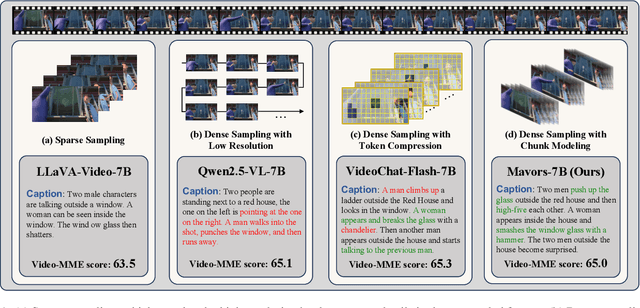

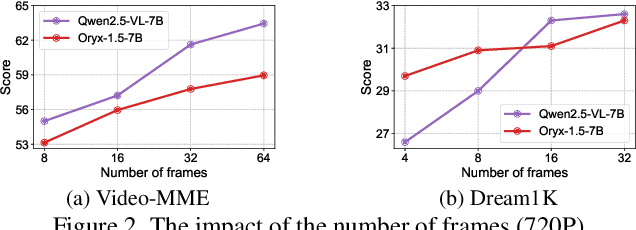
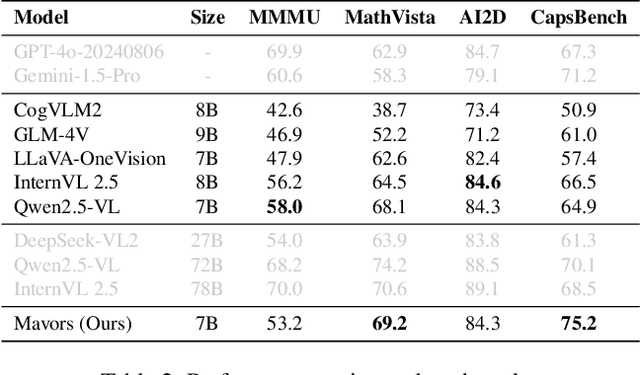
Abstract:Long-context video understanding in multimodal large language models (MLLMs) faces a critical challenge: balancing computational efficiency with the retention of fine-grained spatio-temporal patterns. Existing approaches (e.g., sparse sampling, dense sampling with low resolution, and token compression) suffer from significant information loss in temporal dynamics, spatial details, or subtle interactions, particularly in videos with complex motion or varying resolutions. To address this, we propose $\mathbf{Mavors}$, a novel framework that introduces $\mathbf{M}$ulti-gr$\mathbf{a}$nularity $\mathbf{v}$ide$\mathbf{o}$ $\mathbf{r}$epre$\mathbf{s}$entation for holistic long-video modeling. Specifically, Mavors directly encodes raw video content into latent representations through two core components: 1) an Intra-chunk Vision Encoder (IVE) that preserves high-resolution spatial features via 3D convolutions and Vision Transformers, and 2) an Inter-chunk Feature Aggregator (IFA) that establishes temporal coherence across chunks using transformer-based dependency modeling with chunk-level rotary position encodings. Moreover, the framework unifies image and video understanding by treating images as single-frame videos via sub-image decomposition. Experiments across diverse benchmarks demonstrate Mavors' superiority in maintaining both spatial fidelity and temporal continuity, significantly outperforming existing methods in tasks requiring fine-grained spatio-temporal reasoning.
VidCapBench: A Comprehensive Benchmark of Video Captioning for Controllable Text-to-Video Generation
Feb 18, 2025Abstract:The training of controllable text-to-video (T2V) models relies heavily on the alignment between videos and captions, yet little existing research connects video caption evaluation with T2V generation assessment. This paper introduces VidCapBench, a video caption evaluation scheme specifically designed for T2V generation, agnostic to any particular caption format. VidCapBench employs a data annotation pipeline, combining expert model labeling and human refinement, to associate each collected video with key information spanning video aesthetics, content, motion, and physical laws. VidCapBench then partitions these key information attributes into automatically assessable and manually assessable subsets, catering to both the rapid evaluation needs of agile development and the accuracy requirements of thorough validation. By evaluating numerous state-of-the-art captioning models, we demonstrate the superior stability and comprehensiveness of VidCapBench compared to existing video captioning evaluation approaches. Verification with off-the-shelf T2V models reveals a significant positive correlation between scores on VidCapBench and the T2V quality evaluation metrics, indicating that VidCapBench can provide valuable guidance for training T2V models. The project is available at https://github.com/VidCapBench/VidCapBench.
Attention-guided Self-reflection for Zero-shot Hallucination Detection in Large Language Models
Jan 17, 2025Abstract:Hallucination has emerged as a significant barrier to the effective application of Large Language Models (LLMs). In this work, we introduce a novel Attention-Guided SElf-Reflection (AGSER) approach for zero-shot hallucination detection in LLMs. The AGSER method utilizes attention contributions to categorize the input query into attentive and non-attentive queries. Each query is then processed separately through the LLMs, allowing us to compute consistency scores between the generated responses and the original answer. The difference between the two consistency scores serves as a hallucination estimator. In addition to its efficacy in detecting hallucinations, AGSER notably reduces computational complexity, requiring only three passes through the LLM and utilizing two sets of tokens. We have conducted extensive experiments with four widely-used LLMs across three different hallucination benchmarks, demonstrating that our approach significantly outperforms existing methods in zero-shot hallucination detection.
Curriculum-Enhanced Residual Soft An-Isotropic Normalization for Over-smoothness in Deep GNNs
Dec 14, 2023Abstract:Despite Graph neural networks' significant performance gain over many classic techniques in various graph-related downstream tasks, their successes are restricted in shallow models due to over-smoothness and the difficulties of optimizations among many other issues. In this paper, to alleviate the over-smoothing issue, we propose a soft graph normalization method to preserve the diversities of node embeddings and prevent indiscrimination due to possible over-closeness. Combined with residual connections, we analyze the reason why the method can effectively capture the knowledge in both input graph structures and node features even with deep networks. Additionally, inspired by Curriculum Learning that learns easy examples before the hard ones, we propose a novel label-smoothing-based learning framework to enhance the optimization of deep GNNs, which iteratively smooths labels in an auxiliary graph and constructs many gradual non-smooth tasks for extracting increasingly complex knowledge and gradually discriminating nodes from coarse to fine. The method arguably reduces the risk of overfitting and generalizes better results. Finally, extensive experiments are carried out to demonstrate the effectiveness and potential of the proposed model and learning framework through comparison with twelve existing baselines including the state-of-the-art methods on twelve real-world node classification benchmarks.
Spacecraft depth completion based on the gray image and the sparse depth map
Aug 30, 2022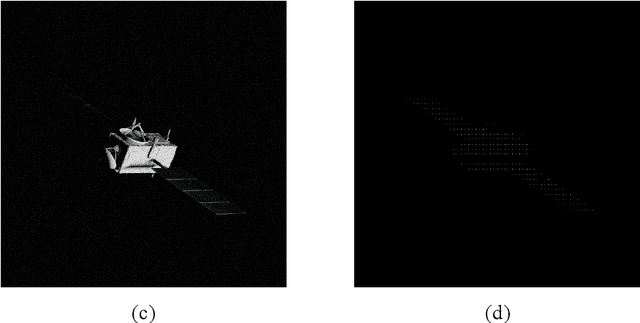
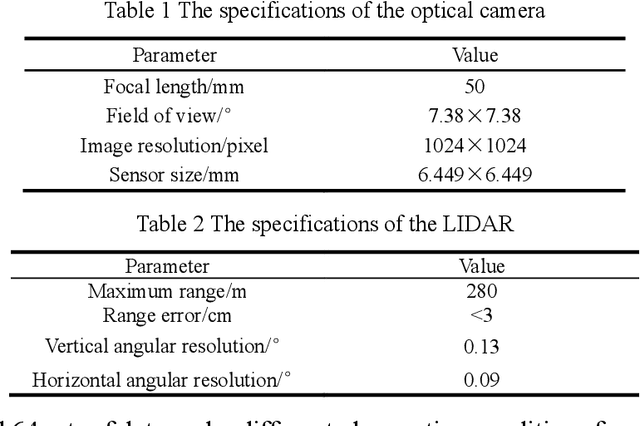


Abstract:Perceiving the three-dimensional (3D) structure of the spacecraft is a prerequisite for successfully executing many on-orbit space missions, and it can provide critical input for many downstream vision algorithms. In this paper, we propose to sense the 3D structure of spacecraft using light detection and ranging sensor (LIDAR) and a monocular camera. To this end, Spacecraft Depth Completion Network (SDCNet) is proposed to recover the dense depth map based on gray image and sparse depth map. Specifically, SDCNet decomposes the object-level spacecraft depth completion task into foreground segmentation subtask and foreground depth completion subtask, which segments the spacecraft region first and then performs depth completion on the segmented foreground area. In this way, the background interference to foreground spacecraft depth completion is effectively avoided. Moreover, an attention-based feature fusion module is also proposed to aggregate the complementary information between different inputs, which deduces the correlation between different features along the channel and the spatial dimension sequentially. Besides, four metrics are also proposed to evaluate object-level depth completion performance, which can more intuitively reflect the quality of spacecraft depth completion results. Finally, a large-scale satellite depth completion dataset is constructed for training and testing spacecraft depth completion algorithms. Empirical experiments on the dataset demonstrate the effectiveness of the proposed SDCNet, which achieves 0.25m mean absolute error of interest and 0.759m mean absolute truncation error, surpassing state-of-the-art methods by a large margin. The spacecraft pose estimation experiment is also conducted based on the depth completion results, and the experimental results indicate that the predicted dense depth map could meet the needs of downstream vision tasks.
 Add to Chrome
Add to Chrome Add to Firefox
Add to Firefox Add to Edge
Add to Edge